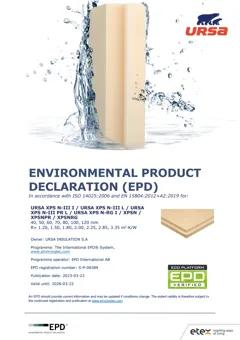

Other manufacturers with similar products
EPD: XPS insulation panels, L=0.033 W/mK, R=1.20 m2k/W, 40 mm, 1.2 kg/m2, 30 kg/m3, Lambda=0.033 W/(m.K), URSA XPS N-III I / URSA XPS N-III L / URSA XPS N-III PR L / URSA XPS N-RG I / XPSN / XPSNPR / XPSNRG, URSA INSULATION SA
Optimize your energy efficiency with URSA XPS insulation panels. These high-performance solutions provide superior thermal insulation and moisture resistance, ensuring comfort and sustainability in your projects. Perfect for both residential and commercial applications.
URSA XPS insulation panels offer excellent thermal performance with a lightweight and rigid structure. They are moisture-resistant and can be easily cut for customization, making them versatile for various insulation needs.
URSA XP...
Manufacturer:
URSA INSULATION SA
Group:
Country of production:
Product name:
XPS insulation panels
Commercial names:
URSA XPS N-III I / URSA XPS N-III L / URSA XPS N-III PR L / URSA XPS N-RG I / XPSN / XPSNPR / XPSNRG
Category:
Insulation
Class:
XPS (extruded polystyrene) insulation
Type:
XPS
Environmental impacts
Global Warming Potential (A1-A3):
3.020 kg CO2e/m²
Technical specification:
L=0.033 W/mK, R=1.20 m²k/W, 40 mm, 1.2 kg/m², 30 kg/m³, Lambda=0.033 W/(m.K)
Available units for calculation:
m², kg, ton, m³
Unique identifier (OCLID):
6498836b52d4c5637398bb1a
Sustainability data background information
EPD number:
S-P-08389
EPD program:
International EPD System
Publication year:
2023
Product Category Rules (PCR):
PCR 2019:14. Construction products (EN 15804+A2) Version 1.11. C-PCR-005 Thermal insulation products (EN 16783:2017) Version: 2019-12-20
Environmental standard:
EN15804+A2
Data source:
EPD URSA XPS N-III I / URSA XPS N-III L / URSA XPS N-III PR L / URSA XPS N-RG I / XPSN / XPSNPR / XPSNRG 40, 50, 60, 70, 80, 100, 120 mm R= 1.20, 1.50, 1.80, 2.00, 2.25, 2.85, 3.35 m2·K/W
Verification status:
Third-party verified (as per ISO 14025)
Upstream database:
ecoinvent


